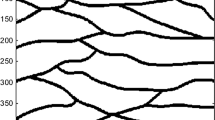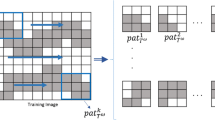Abstract
Multiple-point statistics (MPS) provides a flexible grid-based approach for simulating complex geologic patterns that contain high-order statistical information represented by a conceptual prior geologic model known as a training image (TI). While MPS is quite powerful for describing complex geologic facies connectivity, conditioning the simulation results on flow measurements that have a nonlinear and complex relation with the facies distribution is quite challenging. Here, an adaptive flow-conditioning method is proposed that uses a flow-data feedback mechanism to simulate facies models from a prior TI. The adaptive conditioning is implemented as a stochastic optimization algorithm that involves an initial exploration stage to find the promising regions of the search space, followed by a more focused search of the identified regions in the second stage. To guide the search strategy, a facies probability map that summarizes the common features of the accepted models in previous iterations is constructed to provide conditioning information about facies occurrence in each grid block. The constructed facies probability map is then incorporated as soft data into the single normal equation simulation (snesim) algorithm to generate a new candidate solution for the next iteration. As the optimization iterations progress, the initial facies probability map is gradually updated using the most recently accepted iterate. This conditioning process can be interpreted as a stochastic optimization algorithm with memory where the new models are proposed based on the history of the successful past iterations. The application of this adaptive conditioning approach is extended to the case where multiple training images are proposed as alternative geologic scenarios. The advantages and limitations of the proposed adaptive conditioning scheme are discussed and numerical experiments from fluvial channel formations are used to compare its performance with non-adaptive conditioning techniques.













Similar content being viewed by others
References
Aanonsen S, Navdal G, Oliver D, Reynolds A, Valles B (2009) The ensemble Kalman filter in reservoir engineering—a review. SPE J 14(3):393–412
Abdollahifard M, Faez K (2013) Stochastic simulation of patterns using Bayesian pattern modeling. Comput Geosci 17:1–18
Alcolea A, Renard P (2010) Blocking moving window algorithm: conditioning multiple-point simulations to hydrogeological data. Water Resour Res 46:1–18
Arpat GB (2005) Sequential simulation with patterns. Ph.D. thesis, Stanford University
Caers J (2002) Geostatistical history matching under training-image based geological model constraints. Society of Petroleum Engineers paper SPE77429. Paper presented at the annual technical conference and exhibition, San Antonio, Texas, 29 September – 2 October. doi:10.2118/77429-MS
Caumon G, Strebelle S, Caers J, Journel A (2004) Assessment of global uncertainty for early appraisal of hydrocarbon fields. Society of Petroleum Engineers paper SPE 89943. Paper presented at the annual technical conference and exhibition held in Houston, Texas, USA, 26–29 September 2004. doi:10.2118/89943-MS
Chen Y, Zhang D (2006) Data assimilation for transient flow in geologic formations via ensemble Kalman filter. Adv Water Resour 29(8):1107–1122
Dostert P, Efendiev Y, Hou T, Luo W (2006) Coarse-grain Langevin algorithms for dynamic data integration. J Comput Phys 217:123–142
Dubrule O (1998) Geostatistics in petroleum geology. American Association of Petroleum Geology, Course Note Series 38
Efendiev Y, Datta-Gupta A, Ginting V, Ma X, Mallick B (2005) An efficient two-stage Markov chain Monte-Carlo methods for dynamic data integration. Water Resour Res 41:W12423. doi:10.1029/2004WR003764
Egeland T, Georgsen F, Knarud R, More H (1993) Multifacies modeling of fluvial reservoirs. In: SPE 26502 in proceedings of the SPE Annual Technical Conference and Exhibition
Evensen G (1994) Sequential data assimilation with a non-linear quasigeostrophic model using Monte-Carlo methods to forecast error statistics. J Geophys Res 99(C5):10143–10162
Evensen G (2007) Data assimilation: the ensemble Kalman filter. Springer, New York
Fu J, Gomez-Hernandez JJ (2009) A blocking Markov Chain Monte Carlo method for inverse stochastic hydrogeological modeling. Math Geosci 41(2):105–128
Gilks WR, Richardson S, Spiegelhalter DJ (1996) Markov Chain Monte Carlo in practice. Chapman & Hall, New York
Gu Y, Oliver D (2006) The ensemble Kalman filter for continuous updating of reservoir simulation models. J Energy Resour Technol 128:79
Guardiano F, Srivastava R (1993) Multivariate geostatistics: beyond bivariate moments. In: Soares A (ed) Geostatistics-Troia. Kluwer Academic Publ, Dordrecht, pp 133–144
Haldorsen H, Damsleth E (1990) Stochastic modeling. JPT (spe 20321), pp 404–412
Hansen TM, Mosegaard K, Cordua KS (2008) Using geostatistics to describe complex a priori information for inverse problems. VIII International Geostatistics Congress. Mining Engineering Department, University of Chile. 1: 329338
Hansen TM, Cordua KS, Mosegaard K (2012) Inverse problems with nontrivial priors: efficient solution through sequential Gibbs sampling. Comput Geosci 16(3):593611
Hendricks Franssen H, Kinzelbach W (2008) Real-time groundwater flow modeling with the ensemble Kalman filter: joint estimation of states and parameters and the filter inbreeding problem. Water Resour Res 44(9):W09408
Hoffman BT, Caers J (2005) Regional probability perturbations for history matching. J Petrol Sci Eng 46:53–71
Hu LY, Chugunova T (2008) Multiple-point geostatistics for modeling subsurface heterogeneity: a comprehensive review. Water Resour Res 44(11):1–14
Huang Y, Srinivasan S (2012) Efficient conditional simulation of spatial patterns using a pattern-growth algorithm. Geostat Oslo 2012:209–220
Jafarpour B, McLaughlin D (2009) Estimating channelized reservoir permeabilities with the ensemble Kalman filter: the importance of the ensemble design. SPEJ Soc Pet Eng J 14(2):374–388
Jafarpour B, Khodabakhshi M (2011) A probability conditioning method (PCM) for nonlinear flow data integration into multipoint statistical facies simulation. Math Geosci 43(2):133–164
Journel A (2002) Combining knowledge from diverse sources: an alternative to traditional data independence hypotheses. Math Geol 34(5):573–596
Kashib T, Srinivasan S (2006) A probabilistic approach to integrating dynamic data in reservoir models. J Petrol Sci Eng 50(3):241–257
Khodabakhshi M, Jafarpour B (2013) A Bayesian mixture-modeling approach for flow-conditioned multiple-point statistical facies simulation from uncertain training images. Water Resour Res. doi:10.1029/2011wr010787
Kitadinis P (1995) Quasi-linear geostatistical theory for inversing. Water Resour Res 31(10):2411–2419
Koltermann CE, Gorelick SM (1996) Heterogeneity in sedimentary deposits: a review of structure-imitating, process-imitating, and descriptive approaches. Water Resour Res 32(9):2617–2658
Li L, Zhou H, Hendricks Franssen H, Gomez-Hernandez JJ (2011) Modeling transient flow by coupling ensemble Kalman filtering and upscaling. Water Resour Res. doi:10.1029/2010WR010214
Liu Y (2006) Using the snesim program for multiple-point statistical simulation. Computers Geosci 32(10):15441563
Lopez S, Cojan I, Rivoirard J, Galli A (2009) Process-based stochastic modelling: meandering channelized reservoirs. Analogue Numer Model Sediment Syst: From Understand Predict (Special Publ. 40 of the IAS), 40, p 139
Mantilla C, Srinivasan S, Nguyen Q (2011) Updating geologic models using ensemble Kalman filter for water coning control. Engineering 3(5):538–548
Mariethoz G, Renard P, Caers J (2010a) Bayesian inverse problem and optimization with iterative spatial resampling. Water Resour Res 46(11):1–17
Mariethoz G, Renard P, Straubhaar J (2010b) The direct sampling method to perform multiple-point geostatistical simulaitons. Water Resour Res 46:1–14
Mosegaard K, Tarantola A (1995) Monte Carlo sampling of solutions to inverse problems. J Geophys Res 100(B7):1243112447
Mustapha H, Dimitrakopoulos R, Chatterjee S (2011) Geologic heterogeneity representation using high-order spatial cumulants for subsurface flow and transport simulations. Water Resour Res 47. doi:10.1029/2010WR009515
Nocedal J, Wright S (2008) Numerical optimization, 2nd edn. Springer, Amsterdam
Oliver DS, He N, Reynolds AC (1996) Conditioning permeability fields to pressure data. In: Paper presented at the 5th European Conference for the Mathematics of Oil Recovery, Leoben, Austria, 3–6 September
Oliver DS, Cunha LB, Reynolds AC (1997) Markov Chain Monte Carlo methods for conditioning a permeability field to pressure data. Math Geol 29(1):61–91
Ristic B, Arulampalam S, Gordon N (2004) Beyond the Kalman filter: particle filters for tracking applications. Artech House
Romary T (2009) Bayesian inversion by parallel interacting markov chains. Inverse Probl Sci Eng. doi:10.1080/17415970903234620
Strebelle S (2002) Conditional simulation of complex geological structures using multiple-point statistics. Math Geol 34(1):1–21
Tahmasebi P, Hezarkhani A, Sahimi M (2012) Multiple-point geostatistical modeling based on the cross-correlation functions. Comput Geosci 16:779–797
Tarantola A (2005) Inverse problem theory and model parameter estimation. SIAM, Philadelphia
Weber KJ (1990), Influence of common sedimentary structures on fluid flow in reservoir models. J Petrol Technol :665–672
Wen X, Chen W (2006) Real-time reservoir model updating using ensemble Kalman filter with confirming option. SPE J 11(4):431–442
Zhang T, Switzer P, Journel A (2006) Filter-based classification of training image patterns for spatial simulation. Math Geol 38(1):63–80
Zhou H, Gomez-Hernandez J, Li L (2012) A pattern-search-based inverse method. Water Resour Res 48(3):W03505
Acknowledgments
The authors wish to thank the three anonymous reviewers of this manuscript for their constructive comments and valuable suggestions during the review process. The support for this work was provided in part by Department of Energy, Crisman Institute at Texas A&M, and the Viterbi School of Engineering at USC.
Author information
Authors and Affiliations
Corresponding author
Rights and permissions
About this article
Cite this article
Khodabakhshi, M., Jafarpour, B. Adaptive Conditioning of Multiple-Point Statistical Facies Simulation to Flow Data with Probability Maps. Math Geosci 46, 573–595 (2014). https://doi.org/10.1007/s11004-014-9526-1
Received:
Accepted:
Published:
Issue Date:
DOI: https://doi.org/10.1007/s11004-014-9526-1




